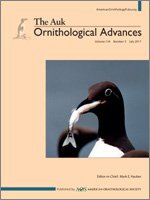In 1917 there were 91 General Notes published in The Auk, 67 of which dealt with new distributional information. As usual, most of those notes came from Massachusetts (17), followed by New York (7), New Jersey (6), Quebec (6), Pennsylvania (5), and Colorado (4). Except for one note about the Eastern Kingbird (Tyrannus tyrannus) occurring in the Bahamas (The Auk 34:209), all notes were about North America.
The winter of 1916–1917, one of the worst in Europe in the 20th century, had a great impact on soldiers fighting in the trenches in World War I and also on bird populations (Carroll 1917, Jourdain and Witherby 1918). In North America, it was a normal winter in the Northeast (Farley 1920), very cold in the Midwest (Diaz and Quayle 1978), and relatively mild on the West Coast (Taverner 1919). Nonetheless, it was a “flight” year for many species on the East Coast and in the central states and the Pacific Northwest. Boreal Chickadees (Poecile hudsonicus) showed up early in New York in the fall of 1916 (34:91–92, 345) and in Massachusetts (34:160–170), eventually being reported as far south as New Jersey (34:218–219) and southern Pennsylvania (34:344–345). Charles W. Townsend had described a new race of Boreal Chickadee from Labrador in 1916 (33:74), and he contended that birds in eastern Massachusetts in the fall of that year were coming from Labrador (34:160–164). Birds lingered into mid-May in Massachusetts (34:486).
Other species that were seen in unusual numbers in Massachusetts that fall and winter were Pine Siskins (Spinus pinus), Common Redpolls (Acanthis flammea), Red Crossbills (Loxia curvirostra), White-winged Crossbills (L. leucoptera), Pine Grosbeaks (Pinicola enucleator), Evening Grosbeaks (Coccothraustes vespertinus), Snow Buntings (Plectrophenax nivalis), Snowy Owls (Bubo scandiacus), and Rough-legged Hawks (Buteo lagopus) (34:92–93). Evening Grosbeaks were reported as far south as southern New Jersey (34:93, 218–219) and Pennsylvania (34:210–212, 340) and as far west as northern Indiana (34:487). They persisted into March in New Jersey (34:479) and into May in Massachusetts (34:478–479). Common Redpolls were also reported in New Jersey (34:218–219) and as far south as North Carolina (34:219–220) and west to northern Indiana (34:487). Pine Grosbeaks and Red Crossbills were also reported from southern New Jersey (34:218–219).
The invasion of Northern Goshawks was impressive across the northern United States (e.g., northern Indiana [34:487]), with birds reaching as far south as Kansas (34:87–88) and Iowa (34:336–337) and appearing in large numbers in the Pacific Northwest (34:212–213; Bowles 1917) and Manitoba (Taverner 1919). The invasion in Massachusetts in the fall of 1916 was a significant factor in the extinction of the Heath Hen (Tympanuchus cupido cupido) on Martha's Vineyard and part of the quadruple whammy that led to its demise. The first was the fire during the breeding season in 1916, which decimated the breeding population, followed by the goshawk invasion of 1916–1917, severe winters like that of 1918–1919, and finally a breakout of blackhead disease (see Gross 1928).
In addition to goshawks, the Pacific Northwest was inundated with Bohemian Waxwings (Bombycilla garrulus), Snowy Owls (34:212–213), and Great Horned Owls (Bubo virginianus; Bowles 1917, Taverner 1919). It was considered a major invasion year for Snowy Owls in California (Grinnell and Miller 1944) and the largest-ever invasion of Bohemian Waxwings in Colorado up to that time (34:341).
Four notes dealt with taxonomic issues, and the most interesting was by Paul Bartsch (1871–1960), who argued that the white phase of the Great Blue Heron (Ardea herodias) found on the Florida Keys should be considered a separate species based on differences in its “habits and psychological manifestation from the Great Blue Heron” (34:86). There was a proposal to lump it in with the Great Blue Heron (33:431), but Bartsch thought that white herons had significantly different behaviors from great blues, warranting species status.
Arlie William Schorger (1884–1972) published a short note on American Kestrels (Falco sparverius) foraging at the edge of wildfires in northern Louisiana, possibly while working on his doctoral research on pine oils. He was a chemist by training and worked on wood and waterproofing. He retired from that career in 1950 and started another as professor of wildlife management at the University of Wisconsin in 1951. He joined the AOU in 1913 and was elected a Fellow in 1951. He was awarded the Brewster Medal in 1958 for his monograph The Passenger Pigeon: Its Natural History and Extinction, published in 1955. His other major work was The Wild Turkey: Its History and Domestication, published in 1966.





